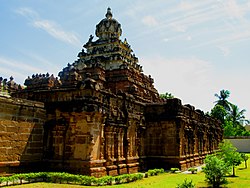
Back كانتشيبورام Arabic كانتشيبورام (تجمع سكان فى كينجليپوت ديستريكت) ARZ कांचीपुरम Bihari কাঞ্চীপুরম Bengali/Bangla কাঞ্চিপুরম BPY Kanchipuram Catalan Kānchipuram CEB Káňčipuram Czech Kanchipuram German Kanĉipuram Esperanto
Kanchipuram
Conjeevaram | |
|---|---|
 Vaikunta Perumal Temple, (731 CE–796 CE), one of the oldest temples in the city | |
| Nickname(s): Spiritual Capital of Tamil Nadu,City of Thousand Temples, Silk City, Temple City, Capital of Pallava Nadu | |
| Coordinates: 12°49′07″N 79°41′41″E / 12.818500°N 79.694700°E | |
| Country | |
| State | Tamil Nadu |
| Region | Tondai Nadu |
| District | Kanchipuram |
| Established | 300 BCE |
| Government | |
| • Type | Mayor-Council |
| • Body | Kanchipuram Municipal Corporation |
| • Mayor | M. Mahalakshmi (DMK) |
| • Corporation Commissioner | G. Kannan I.A.S |
| • Member of legislative assembly | C.V.M.P. Ezhilarasan |
| • Member of Parliament | G.Selvam |
| Area | |
• Total | 36.14 km2 (13.95 sq mi) |
| • Rank | 15 |
| Elevation | 105 m (344 ft) |
| Population (2011)[1] | |
• Total | 232,816 |
| • Rank | 15 |
| • Density | 6,400/km2 (17,000/sq mi) |
| Demonym | kanchipuramites |
| Languages | |
| • Official | Tamil |
| Time zone | UTC+5:30 (IST) |
| PIN | 631501-631503 |
| Telephone code | 044 |
| Vehicle registration | TN-21 |
| Nominal GDP(2023-24) | ₹14,425 crore (US$1.7 billion) |
| Website | tnurbantree |
Kanchipuram (IAST: kāñcipuram; [kaːɲdʑipuɾam]),[2] also known as Kanjeevaram, is a stand alone city corporation, satellite nodal city of Chennai in the Indian state of Tamil Nadu in the Tondaimandalam region, 72 km (45 mi) from Chennai – the capital of Tamil Nadu. Known as the City of Thousand Temples, Kanchipuram is known for its temple architectures, 1000-pillared halls, huge temple towers and silk saris. Kanchipuram serves as one of the most important inland tourist destinations in India. Kanchipuram has become a centre of attraction for foreign tourists as well. The city covers an area of 36.14 km2 (13.95 sq mi) and an estimated population of 232,816 in 2011. It is the administrative headquarters of Kanchipuram District. Kanchipuram is well-connected by road and rail.
Kanchipuram is a Tamil name formed by combining two words, "kanchi" and "puram," together meaning "the city of kaanchi flowers" (due to the abundance of kaanchi flowers in those regions). The city is located on the banks of the Vegavathy and Palar Rivers. Kanchipuram has been ruled by the Pallavas, the Medieval Cholas,[3] the Later Cholas, the Later Pandyas, the Vijayanagara Empire, the Carnatic kingdom, and the British, who called the city "Conjeeveram".[3] The city's historical monuments include the Kailasanathar Temple and the Vaikunta Perumal Temple. Historically, Kanchipuram was a centre of education[4] and was known as the ghatikasthanam, or "place of learning".[5] The city was also a religious centre of advanced education for Jainism and Buddhism between the 1st and 5th centuries.[6]
In the Vaishnavism Hindu theology, Kanchipuram is one of the seven Tirtha (pilgrimage) sites, for spiritual release.[7] The city houses the Varadharaja Perumal Temple, Ekambareswarar Temple, Kamakshi Amman Temple, and Kumarakottam Temple, which are some of the major Hindu temples in the state. Of the 108 holy temples of the Hindu god Vishnu, 15 are located in Kanchipuram.[8]
The city is most important to Sri Vaishnavism, Shaktism and then Shaivism. Most of the city's workforce is involved in the weaving industry.[9]
Kanchipuram is administered by a Special grade municipality constituted in 1947. It is the headquarters of the Kanchi matha, a Hindu monastic institution believed to have been founded by the Hindu saint and commentator Adi Sankaracharya, and was the capital city of the Pallava Kingdom between the 4th and 9th centuries.
Kanchipuram has been chosen as one of the heritage cities for HRIDAY - Heritage City Development and Augmentation Yojana scheme of Government of India.
- ^ "Kanchipuram municipal corporation".
- ^ Malalasekera 1973, pp. 112–13.
- ^ a b Chisholm, Hugh, ed. (1911). . Encyclopædia Britannica. Vol. 6 (11th ed.). Cambridge University Press. p. 943.
- ^ Rao 2008, p. xviii.
- ^ K.V. 1975, p. 80.
- ^ Thapar 2001, pp. 344–345.
- ^ Jean Holm; John Bowker (2001). Sacred Place. Bloomsbury Publishing. p. 70. ISBN 978-1-62356-623-4.
- ^ Gupta 2001, p. 51.
- ^ Kanchipuram Industrial profile 2012.

